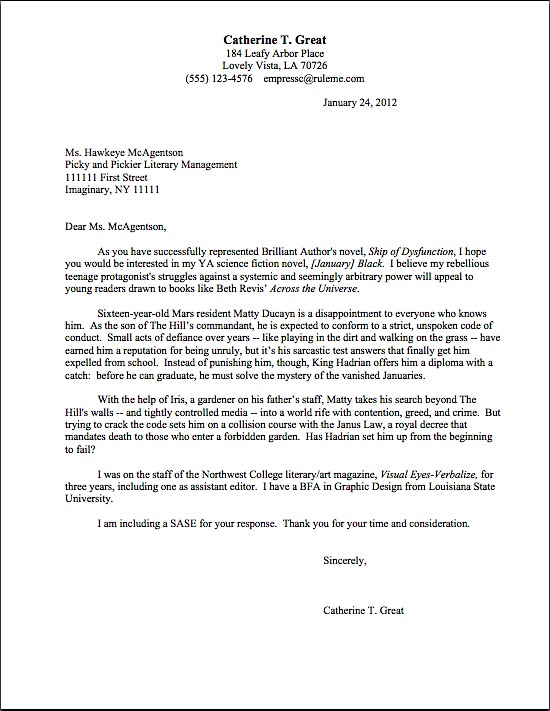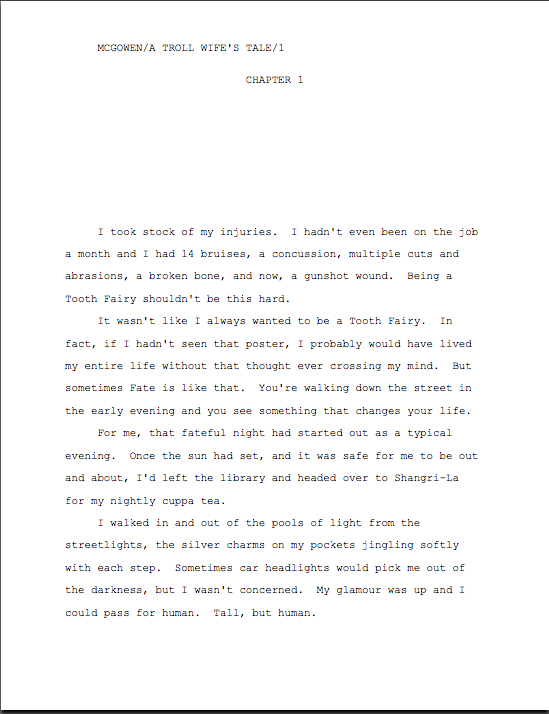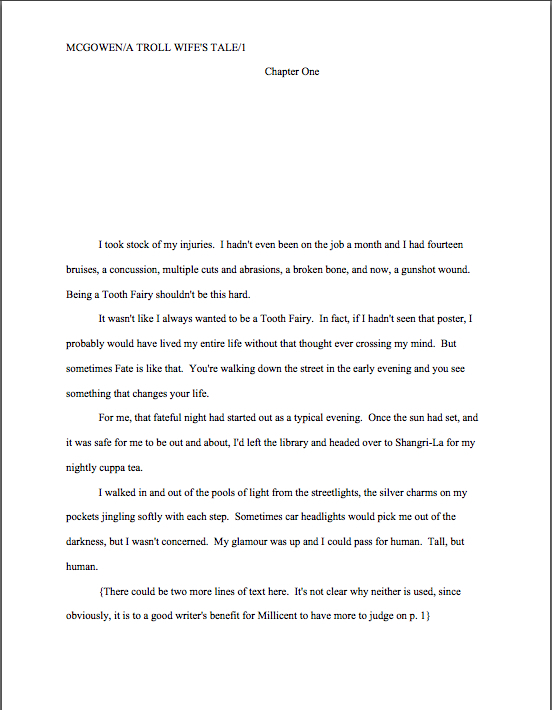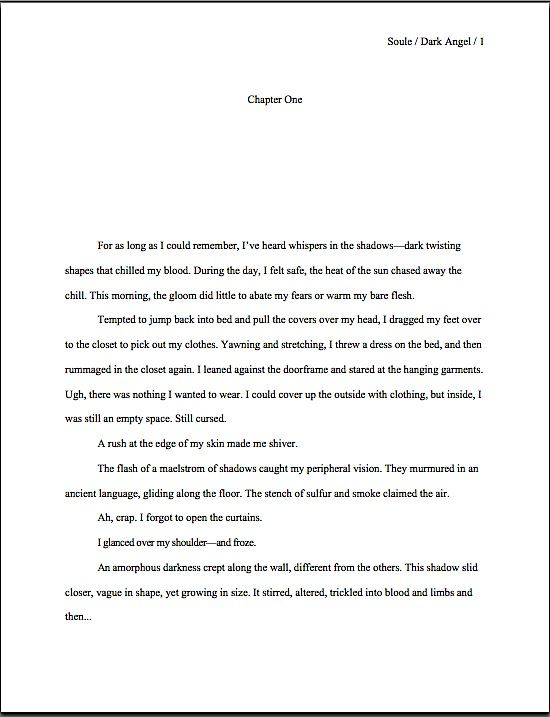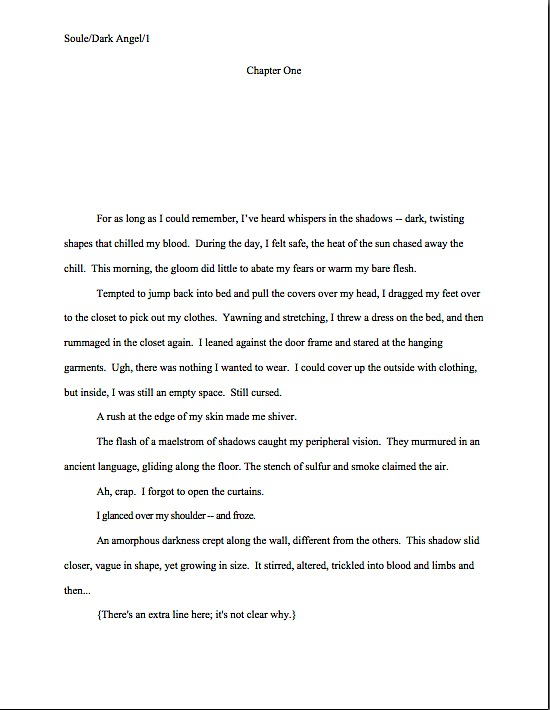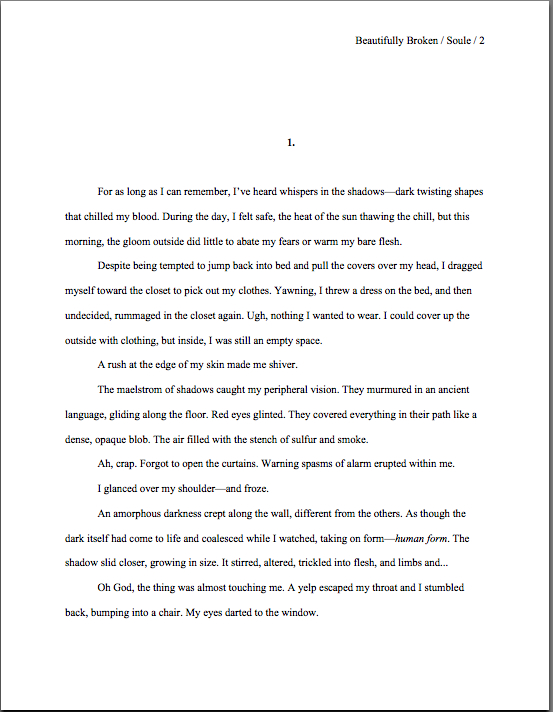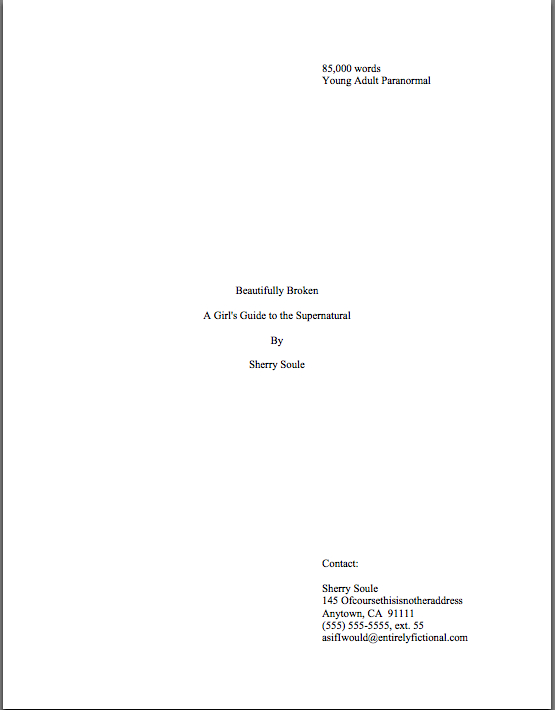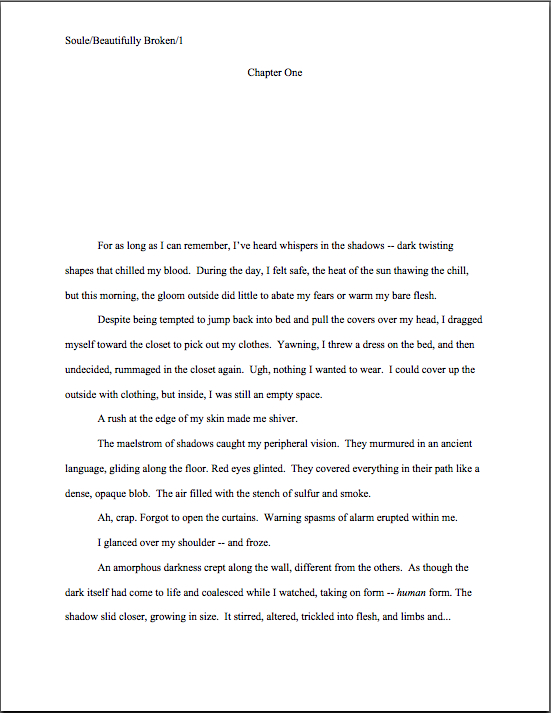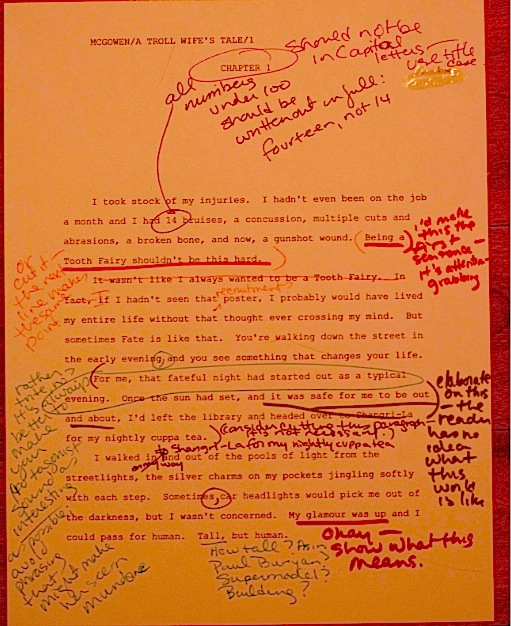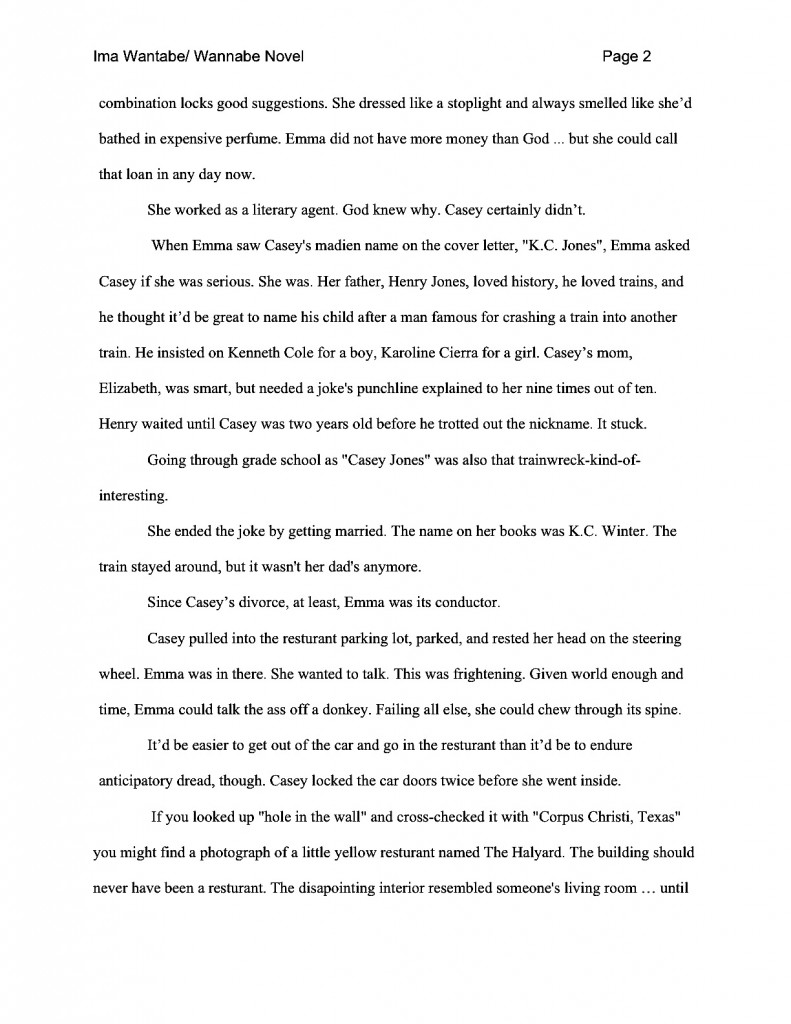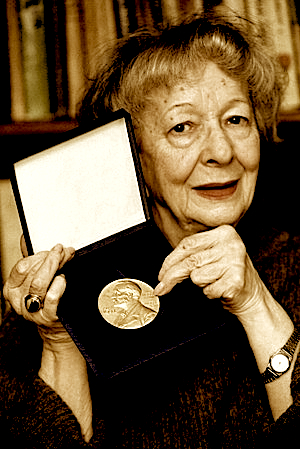Have you been finding the real-world examples we’ve been examining of late constructive, campers, or have you been twiddling your thumbs, tapping your fingers, and wishing with all of your might that Queryfest might end, so we might get back to discussing craft? Or — and I must admit, I would have begun suspecting this, had I been on the reading end of Author! Author! for the last couple of months — have you begun speculating that I’ve been stretching our discussion of querying out as long as possible in order to discourage all of you from sending out letters to agents before the Great New Year’s Resolution Paper Flurry of 2012 roars to a close?
Okay, I’ll admit it: I have been dragging my feet a trifle, but I honestly have been extremely busy. I’m running an editing special on query packets this month and next, and honestly, I’ve been swamped. (There are a few slots still available, should you be interested, but they’re booking up fast.) I have been enjoying showing you just how big a difference a few relatively minor revisions in a query letter can make to how it strikes the weary, over-taxed eyes of our old pal, Millicent the agency screener.
For those of you new to the mysteries of querying, Millicent is the collective moniker of the legions of sharp-eyed, hard-working, literature-loving (yes, in spite of everything) assistants employed by agencies large and small to process the thousands upon thousands of query letters they receive each year. At most agencies, Millicent is also the first reader of requested manuscripts, winnowing the hundreds of submissions down to the few that her bosses, the agents to whom aspiring writers address their queries, have time to read. In a very real sense, then, Millicent is the audience at whom a savvy querier or submitter should be aiming his efforts.
Most aspiring writers are a trifle shocked to learn of Millicent’s existence; pretty much every writer tends to assume that the agent of his dreams has time to peruse, if not each and every query sent to her attention, at least one’s own. That’s the agent’s job, isn’t it, to seek out exciting new literary talent?
Actually, it isn’t, at least not primarily. A traditional agent — as opposed to the kind that makes a living not by selling books for authors, but by other means such as charging for manuscript feedback or taking kickbacks for referring aspiring writers to editing services — makes money only when he sells his existing clients’ manuscripts or book proposals. He takes a percentage of the advance, as well as any royalties. (If you’re not sure of the difference or how published authors get paid, you might want to check out the ADVANCES and ROYALTIES AND HOW THEY WORK categories on the archive list conveniently located at the bottom right-hand side of this page.) Going through queries and submissions, then, as well as working with clients in order to get a work ready for submission to publishing houses, is essentially done on spec in anticipation of future earnings.
That means, in practice, that while landing an exciting new voice or great book concept (or, even better, both in the same work) is potentially lucrative for an agency, getting paid in the short term depends mostly upon hustling to promote the manuscripts and proposals it currently has under contract, making sure that the publishers of existing clients’ books deliver advances and royalty checks on time (not a foregone conclusion in every instance, alas), and, ideally, helping already-established clients crank out more books for eager audiences. Because all of that is awfully darned labor-intensive, even a very successful agency typically takes on only a handful of new clients per year.
Which means, to be blunt about it, that a good agent usually doesn’t have nearly enough time to screen all of the queries aimed at him — and the more commercially successful his clients are, the more likely that is to be true. (Oh, you think Stephanie Meyers’ agent doesn’t receive a significantly higher volume of queries than your average bear?) Thus Millicent: while her boss concentrates on near-term profits, she performs the long term-oriented task of sifting through the mountains of queries and hills of submissions to come up with the happy few most likely to — pardon my being crass about it — rake in some dosh down the line.
Her efforts — and they are often substantial — free the agent of your dreams to concentrate on his current client list. That may be a touch frustrating when a writer is first trying to catch an agent’s eye, but believe me, you’ll be grateful for it once you’re gracing that client list.
I always like to remind aspiring writers of that around this time of year, when so many creative minds first tackle (or re-tackle) the daunting, lengthy, and often soul-compressing task of approaching agents with a first book. The Millicents of the world do not, by and large, enjoy rejecting writers, nor do they generally make the rules that determine what is and is not a rejection-worthy offense in a query, but it is in fact their job to reject virtually everything that comes across their desks.
That’s just how the system works, I’m afraid. An aspiring writer can waste a lot of time and energy in resenting that, without doing herself or her book any good.
In fact, most do. As any talented listener who has ever spent more than forty minutes at a writers’ conference knows, it’s not at all uncommon for even very ambitious writers to devote a far greater proportion of her oomph to complaining about how difficult it is to land an agent than to walking up to agents to pitch or sending out queries. Indeed, it’s not unheard-of for a genuinely gifted writer to send out only one, two, or twelve queries, then give up entirely, switching all of the energies previously expended in trying into seething and feeling hurt.
I’m not judging that response; I would be the last to deny that rejection hurts. It’s hard not to take personally. However, as a professional writer, I’m here to tell you that frequent rejection isn’t the exception for successful writers; it’s the norm. It often takes an agent dozens of submissions to sell a client’s book; agented writers pitch book ideas to their agents and editors all the time, only to see them shot down.
They don’t stop trying, you see. Nor should you. Yes, you’re probably going to get rejected a few times, but you can’t succeed if you don’t try. And keep trying, even if it takes a hundred queries. (Not at all an unusually high number for first-time authors these days, by the way.)
Chant it with me now, long-term readers: the only manuscript that stands no chance of getting published is the one that the writer, sometimes for excellent reasons, has stopped sending out. Or never worked up the nerve to send out in the first place.
It also helps to be humble enough — and professional enough — to be open to the possibility that the query itself, and not the book it presents, is what is tripping Millicent’s infamously sensitive rejection response. As we’ve seen throughout this series, it isn’t always the big faux pas that send her reaching for the form-letter rejection pile; it’s frequently the small gaffes.
Or, more commonly, a collection of them. Query red flags, like manuscript problems, are as sociable as ants: Millie rarely sees one traveling alone.
Bearing that in mind, I’d like to present you with another quite good querying effort by a brave and generous Author! Author! reader, a clever, creative soul I shall dub Catherine T. Great. From a writerly perspective, what I’m about to show you is not only good; it’s borders on the superlative. Just you wait and see.
Yet to Millicent’s finely-honed eye, the query that follows suffers from a number of small maladies. Not a single one of these problems would necessarily constitute a severe enough pneumonia to make us despair of the patient’s chances, perhaps, but taken together at the end of a long, tiring day of querying, the symptoms might well prove fatal to the chances of what genuinely sounds like an interesting book.
Our goal today, then, will be to ferret out and clear out those minuscule ailments, so that the patient may thrive.
So dig out your reading glasses, please, and see if you can diagnose the problems, as well as the strong points of this letter. As always, I apologize for the bizarre blurriness my blogging program lends to page shots (as opposed to photographs, which it passes along to you in loving detail); to try to ease it, I shall try making the pictures a little bigger this time around. If you are still having trouble seeing individual words or formatting specifics, please try holding down the COMMAND key and pressing + to enlarge the image.
Pretty darned persuasive, is it not? Let’s pause for a moment to consider why. It’s upfront about why Catherine decided to query Hawkeye — the reference to one of her client’s books is professionally flattering without coming across as at all obsequious — makes the book category clear, and goes above and beyond in providing a second parallel published book. Obviously, this is a writer who has done her homework (although I, for one, would have liked to know why the book would appeal to Ms. Revis’ readers, I must confess). It’s properly formatted, polite and professional in tone, and includes credentials relevant to publishing. The book’s description is a trifle on the long side, but it presents a compelling story arc.
Heck, she even came up with a title for Brilliant Author’s work that elicited a bona fide chuckle from me — and believe me, after six and a half years of coming up with querying examples for aspiring writers, I welcome a query effort that makes me chuckle. Well done, Catherine!
Yet despite all of these very positive elements, it contains two common problems — one structural, one creative — that might well give Millicent pause. Hint: we talked about one of them at fairly great length last time.
Hark! Do I hear a fairly hefty percentage of you leaping to your feet, exclaiming vigorously, “I see it, Anne! Catherine included that unnecessary cliché about the manuscript’s being complete,” you’ve already earned your gold star for the day. Chant it with me, recent post-rememberers: since a US-based agent could not possibly sell — or even submit to editors at publishing houses — an unfinished first work of fiction, agencies do not accept partial novel manuscripts. Therefore, any query for a fiction manuscript is assumed to be for a completed manuscript.
How I — and everyone currently working at any agency in North America — wish that logic were more widely known. The Internet, however, has an intriguing habit of making bad examples and ill-informed advice at least as pervasive as good examples and expert advice. Trust me, “But I saw an example online that did it that way!” carries precisely no weight with Millicent — or, indeed, anyone who reads for a living.
Sorry to be the one to break that to you. But while I’m at it, may I caution against the utterance of any sentiment that remotely resembles, “But my mom/husband/wife/best friend/writers’ group loved my book!” in the presence of anyone who has ever set foot in a literary agency? Not to cast aspersions upon those who love you, but from the pros’ point of view, non-professional assessments of literary quality tend not to be worth the paper they are written upon.
I have some bad news about the Easter Bunny, too, as well as George Washington and that cherry tree. I don’t want to shatter too many of your illusions in one day, though, so I’ll hold off on those.
Do I spot some raised hands out there? “But Anne,” Catherine’s well-wishers across the globe call out, and with good reason, “I’ll fess up: I thought that complete at X words was required verbiage for a query, too. How else would one work in the information about length gracefully?”
Oh, I don’t know — how about by constructing a graceful, original sentence, rather than lifting one somebody else wrote? English is a marvelously complex language that permits a great variety of sentence construction, after all, and part of the writer’s task in the query letter is to convince Millicent that he can, you know, write.
As I’ve mentioned before, it’s a myth (and, since the rise of the Internet, an astonishingly pervasive one) that every agent currently treading the earth’s crust demands to see a word count in the query. Some do, of course, but they tend not to be particularly shy about expressing that preference: if its inclusion is important to them, they will mention it in the agency’s submission guidelines.
And if they do not bring it up specifically — or if, as is more often the case, the agency has not posted guidelines for queriers more prescriptive than please query before sending materials — it’s honestly not going to help you to include the word count unless it falls smack dab in the middle of the normal range for your chosen book category. If it’s much longer or much shorter, including it could provide Millicent with an additional reason to reject the query.
Which, naturally, is why agencies that ask for this information want to know: because so many first manuscripts are in fact quite a bit longer or quite a bit shorter than the norms for the category (usually the former, for fiction), having this information handy in the query can save Millicent quite a bit of time — and the agency an entire step — in the rejection process. That’s just common sense: instead of being charmed by the query, requesting the manuscript, and waiting until it arrives to discover it’s a five-pound behemoth that would be astronomically expensive to print (or a six-ounce novella not long enough to hold hard covers apart), a Millicent at a word count-requesting agency can simply glance at those numerals and reject the project immediately.
Lucky for her that she didn’t have a chance to fall in love with your writing first, eh?
In Catherine’s case, even though her word count isn’t large enough to risk knee-jerk rejection, the book is on the longer end for YA. So if Hawkeye’s agency didn’t insist in its guidelines upon seeing those digits, is it really the best strategy for her to include them?
Check those guidelines carefully. It’s in your interest to verify the querying requirements of every single agent you plan to approach, anyway, to ascertain that they don’t want you to send additional materials — an author bio, for instance, or some special length of synopsis.
I know, I know: the let’s-use-a-template mentality would prefer that every agency in creation did in fact expect precisely the same elements in a query, or in a query packet, for that matter. A simple perusal of any fifteen agency websites featuring submission guidelines, however, will abundantly demonstrate that’s not the case.
And before anyone out there bellows, “But I saw something on another website that said my query would be doomed if I didn’t include the word count,” remember, folks, the vehemence with which a piece of querying advice is presented is not a particularly good indicator of how helpful that advice will be in practice. Especially, as in this case, when literally millions of queriers have taken the same piece of advice, rendering screening annoyingly repetitious for Millicent. “What on earth,” she mutters over the 78th iteration of complete at X words she’s seen in a morning, “makes them think they need to tell me something this obvious? And why oh why do 99% phrase it exactly the same way?”
This is not, of course, the intended effect. Quite the opposite, in fact. Like many aspiring writers, Catherine almost certainly included this stock phrase because she saw — although not here at Author! Author! — a template that featured it, and concluded, not unreasonably, that it was just necessary industry-speak that would elevate her query from the intriguing to the intriguing and professional.
Instead, it tells Millicent something completely different: despite Catherine’s genuinely impressive magazine credentials — did you catch that glorious platform paragraph? — she probably doesn’t know very much about how book-length fiction is sold or how agencies work. Perversely, that perception might actually make that magazine background work against Catherine at the query stage. Millicent might well conclude that her boss, or at any rate someone at the agency, would have to invest additional time in training such a client in the differences between what the magazine world expects in a manuscript and what book publishers do.
Counterintuitive, isn’t it? Contrary to popular opinion, not every piece of writing intended for publication should be formatted identically, nor is all publishing one big industry. What’s appropriate in a submission, or even in a query, depends entirely upon the venue. Agents deal with book publishers, by and large, so they expect their clients to adhere to the norms of that industry: reasonable, right? It’s equally reasonable for magazines to expect submitters to adhere to short story format, newspapers to look for A.P. format, and academic journals to adhere to their own esoteric standards.
So while Catherine’s extensive experience working with text intended for publication and producing print-ready work under deadlines undoubtedly constitute fine arguments for snapping her up as an agency client, presenting that information to Millicent immediately after having used a phrase that she has come to associate with those brand-new to book publishing might create an unintended effect. Specifically, the impression that while this is a writer accustomed to adhering to an industry’s writing expectations, she might experience some difficulty switching to Millie’s boss’ expectations.
Especially, as in this case, when that phrase appears at a rather odd point in the letter. Does anybody see a problem — from Millicent’s speed-reading perspective, that is — with where the information in that paragraph falls?
In case that last sentence was too subtle: why might it be to Catherine’s advantage not to make Millie read almost to the end of the query — or, if it’s an e-mailed query, to force her to scroll down — before conveying that information?
If you have been jumping up and down for the last few lines, exclaiming, “I know! I know! Millie won’t necessarily read that far to find out the book category,” feel free to raid the gold star cabinet again. Remember, a screener at an agency of any stature has to read through a LOT of queries in a day, and it’s her job to reject as many as she reasonably can, as fast as humanly possible.
And what’s the single simplest ground upon which to reject a query? Shout it out, Queryfest faithful: if the query appears to be for a book in a category Millicent’s boss doesn’t represent.
Yes, sometimes even if it doesn’t appear from the first paragraph that the letter’s been correctly targeted. Remember, if Millicent finds a rejection trigger early in a query, she’s not necessarily going to have the time to read on for others. In the midst of a busy day, she’s far, far more likely simply to stop reading and stuff a form-letter rejection into the enclosed SASE. (Catherine’s been redundant here in mentioning the SASE in the body of the letter and writing Enclosure at the bottom, by the way; once would have been sufficient.) Or, as is even more common these days, just to hit the DELETE key or toss the query into the recycling bin.
Fortunately for Catherine and her book — which, again, sounds like a good read — this dreadful fate is not all that hard to avoid. As is, alas, all too often the case with good writers who have just taken advice from too many sources, ironing out the wrinkles to present the book more pleasingly to Millicent’s eye can be done with very few keystrokes.
Stop laughing; it’s true. Just a few very minor revisions would make an immense difference here. Even just altering what we have talked about so far — taking out the stock phrasing and the word count, making it easier for Millicent to tell the book category from the get-go, removing the redundancy about the enclosure — would improve this query’s chances. Take a gander:
Stronger, isn’t it? That took less than a minute’s worth of keystrokes to accomplish.
I sense some nervous shifting in desk chairs out there in the ether. “But Anne,” YA writers across the globe point out, “I recognize that this version is tighter — it did seem a trifle conceptually redundant in the first to mention the book category twice. In Catherine’s defense, though, she did tell Millicent right off the bat the first time around what the book category was: YA. So why not just say that in the first paragraph, rather than specifying that it is YA science fiction?”
Good question, chair-shifters, and one that deserves a direct answer: because just as not all science fiction is aimed at a YA audience, not all YA appeals to science fiction readers. Nor do all YA-representing agents handle SF or fantasy aimed at that demographic. I must confess, though, from the description in the query, I’m not entirely sure why she has labeled this story as YA science fiction, rather than placing it the more capacious umbrella of YA fantasy. It’s entirely possible that this story contains elements that would make it fit more comfortably into the SF world — like, say, the cryogenically frozen space travelers featured in Across the Universe – but as the lengthy description doesn’t bring up any SF-specific elements, I suspect Millicent might be perplexed by the category choice.
And while we’re at it, the king’s answer lies within what? The garden, or Matty?
To be fair, since Catherine has clearly done her homework about this agency, she knows that Hawkeye does indeed represent YA fantasy and adult SF, so she probably could have gotten away with this particular ambiguity in her query were it not for a storytelling choice in the descriptive paragraphs. Any guesses why Millicent needed to know before the description that this book was SF or fantasy?
At the risk of running out of gold stars, help yourself to three if you bounded from your chair to cry, “Because while the first descriptive paragraph reads like YA, it does not read like either SF or fantasy!” For some reason that defies Millicent’s understanding, writers aiming at YA subcategories stumble into this pothole all the time: in their laudable attempt to present the premise in an engaging YA voice, they tend to give short shrift to the specialty elements.
I hear you giggling, but you’d be astonished at how many YA romance queries omit the romance (one of the reasons I didn’t transplant the with romance elements part of the original science fiction justification, incidentally), how many YA paranormals neglect to bring up the werewolf until the last sentence of the description, how many YA fantasies neglect to mention any fantastic plot points, and so forth. It’s as though these queriers believe that there’s just one big YA category that covers every single literary possibility for readers aged 13-17, and that a commitment to representing YA means swearing off the ability to specialize in certain voices or subject matter.
If that last paragraph made you gasp in terror, clutch your writhing entrails, and wish devoutly that you’d done a touch more research on what those agents you just queried had sold recently, well, you’re not alone. YA-screening Millicents are constantly overwhelmed with masses of queries that betray a belief that YA agents don’t specialize.
See now why I was so adamant about Catherine’s stating the subcategory in paragraph 1? Even if Millicent happened to be intimately familiar with both Brilliant Author and Beth Revis’ excellent efforts to entertain the youth of this part of the universe, it isn’t her job to guess that despite the fact that Matty’s story is presented at first as straightforward YA — it isn’t hard to imagine this story set in any strict school, is it? — he’s living in a fantastic world. It’s the descriptive section’s job to demonstrate it, and to do it right away.
Not having read the manuscript in question (which, again, sounds like a hoot, Catherine) and having no idea what the Hill is (when it first appears in the description, it seems to be Matty’s school, but by the end of the paragraph, it appears to be a regional designation), I’m reluctant to make up SF or fantasy elements to add to that paragraph. I can suggest a revision strategy, though: why not just beef up the initial description of Matty to include some off-world tidbit? Like, perhaps, this:
Sixteen-year-old Mars resident Matty Ducayn is a disappointment to everyone who knows him. As the son of The Hill’s commandant, he is expected conform to a strict, unspoken code of conduct. Small acts of defiance over years—like playing in the dirt and walking on the grass—have earned him a reputation for being unruly, but it’s his sarcastic test answers that finally push his masters over the edge. After his preparatory school expels him, he’s summoned by his sponsor…the king…to answer for the offense.
Doesn’t leave Millicent in suspense for long, does it? Again, that’s a huge improvement, given that this change required precisely six keystrokes.
While we have that excerpted paragraph in front of us, though, may I ask you a favor? Will you rise from your chair, back up an additional few feet from your computer screen, and take another look at that paragraph, please?
Tell me, what was the first thing that struck your eye? If it was those two rather perplexing sets of ellipses, you’re not alone. Yes, YA is on the whole quite a bit more open to what columnist Herb Caen used to call three-dot journalism than adult fiction (or nonfiction, for that matter), but here, those dots just don’t make sense. What, Millicent is left to wonder, is Catherine trying to say that could not have been adequately conveyed by the grammatically-correct commas:
After his preparatory school expels him, he’s summoned by his sponsor, the king, to answer for the offense.
Since the query is peppered with other, correctly used ellipses, what Millicent is most likely to conclude is twofold: first, Catherine really likes herself an ellipsis — and that the manuscript being queried is stuffed to the proverbial gills with ‘em. While neither would necessarily strike someone reading the book itself as problematic, if Catherine has used them discreetly and effectively throughout, repeating a stylistic trick several times within a space of text as short as a query implies that the author may use them that frequently on the manuscript page.
And if you’re not sure why that might present a problem, back up again and take a peek at the previous examples. That many ellipses on any given page of a published book would be mighty eye-distracting, wouldn’t they? Like most literary slight-of-hand, a device like this works best if it is used sparingly; indulge in it too much, and the reader’s eye begins to skim past it.
Again, though, not having read the manuscript in question, I’m reluctant to draw any conclusions whatsoever about how it is written. Millicent, I need hardly tell you, is not so shy. So let’s, just for the sake of appeasing her, limit the ellipsis use to once on the page, where removing it would make the greatest difference.
While I’m removing eye-distracters, I’m going to go ahead and excise the extra s in the possessive in that first paragraph. Yes, recent changes in journalistic practice have rendered forming a possessive by adding ‘s to — shudder — any noun, regardless of whether it happens to end in an s or not, but to most of us who read for a living, it still looks wrong. (Mostly because it would have been considered flatly and unquestionably wrong 20 years ago.) To us, the rule change just seems like a concession to those incapable of understanding a rule containing more than one element.
I was, fortunately for the Author! Author! community, brought up to exercise kind forbearance toward those wolf-raised miscreants who objected to punctuation that could not be applied identically in every instance. Millicent might, too, if she did not enjoy the good luck of being trained by a grammar rule-hugger, and her boss might well be too busy to care.
When people do object to rule-flattening, however, they tend to object to it pretty violently, so why take a chance in a query? Or, for that matter, tempt Millicent’s ire by adopting the AP style of capitalizing the first letter after a colon, as if it were the beginning of a new sentence? (See earlier section on different types of publishing embracing different standards.) For the sake of Millie’s blood pressure, I’m going to alter that, too.
That little peroration out of my system, let’s turn again to the query page. What jumps out at you now?
It was the dashes, wasn’t it? (And wasn’t it amazing how little difference removing those ellipses made to the actual meaning of those sentences?) This time around, it’s not just the frequency with which Catherine uses them here that would strike Millicent as odd, but the fact that she does not present them consistently. Half the time, they show up as emdashes, those long lines stretching from one word to the next, but the other half, they consist of two dashes, with no spaces between them and the words on either side.
In a book manuscript, neither would be correct: in standard format, dashes are doubled, with a space at either end. Care to extrapolate what Millicent’s assumption about the manuscript might be, based upon how dashes are used here?
Uh-huh: it would require proofreading, something not all agencies are willing to invest time in doing for their clients. So let’s go ahead and make those dashes both manuscript-friendly and consistent, shall we? Since the book’s title contains an unexplained-and-offbeat punctuation choice, Catherine will be best off if it’s the only one in the letter.
I’m also, for the sake of consistency, regularize the number of spaces after periods and colons: in the original query, sometimes it was one, sometimes two. While I’m at it, I shall correct the incorrect article in the platform paragraph, add the missing one, and introduce some clarifying commas.
Ah, that’s better: without the visual distractions, it’s easier to concentrate on the content of the letter. As a fringe benefit, the offbeat punctuation in the title now comes across as a definite authorial choice made by a rule-savvy writer, rather than — and I’m sorry to put it this way, Catherine, but it is how many Millicents might have seen it before — as a typo.
And speaking of typos, did you catch the one that I missed last time around? I’ll add the missing preposition in the next version.
Own up, now: you’re surprised that a query this good from the get-go could benefit from this much tinkering, are you not? That’s the difference between how Millicent — and any well-trained professional reader — looks at a page and how most people do. To those with the eye, these small changes make a world of difference, elevating the query several notches up the professionalism scale.
Believe it or not, I could tinker with this more — personally, I think that including a few vivid, one-of-a-kind specifics would make this letter even better, but lacking those, I’m not going to impose my guesses upon Catherine’s plot. A dandy place to start: how about adding a sentence showing Millicent how Matty’s world differs from ours?
Ah, you will say, but how would Catherine find the space to include her unique details? To an editor’s eye, the answer’s simple: since including so much of the plot here renders causation a trifle unclear, cut a bit of it out. Remember, the point of a book description in a synopsis is not to summarize the plot, but to present the premise and central conflict, preferably while depicting the protagonist as an interesting person in an interesting situation.
Here, the description not only achieves all that, but goes considerably farther, suggesting how the central conflict gets resolved. While that’s not inherently problematic, Millicent’s expecting this part of the query to run only 3-4 sentences long. She seldom objects to queries on the ground that they are too short, if you catch my drift. She also tends to prefer descriptive sentences in the active voice to ones whose structure implies that things happen to the protagonist, rather than the protagonist’s propelling the plot along.
So despite the fact that I suspect the cuts I am about to make will cause Catherine to clutch her heart and murmur, “Sacre bleu! But it’s an essential twist, I tell you,” I invite the rest of you to consider whether tightening the lengthy description genuinely sacrifices much of this query’s original charm. In order to sweeten the trade-off a little, I’m going to use a bit of that freed-up space to show Millicent why I think, based upon what I know of this storyline, this book might appeal to readers of Beth Revis’ work.
Oh, and before I show you the revised version, allow me to ask: had you noticed that title of this book appeared in capital letters (one acceptable means of designating a title), while the other titles appeared in italics (a different means of same)? Millicent would have. Again, consistency is the querier and submitter’s friend: professional readers’ eyes automatically zoom in on the unexpected.
What, you may be asking, is the mystery of the vanished Januaries? Beats me; I was merely searching for shorthand for that rather confusing (for someone who has not read the manuscript, anyway) bit about the search. It’s a nice phrase, though, isn’t it, and one that whets your appetite to read the manuscript?
It just goes to show you: sometimes in a query, less actually is more, as long as it is clearly presented. It’s not the book description’s job, after all, to depict the central conflict in its entirety, after all; that’s the manuscript’s job. All the query has to do — and it’s a tall enough order without adding requirements, thanks — is intrigue Millicent enough that she will ask to see pages.
After that, Catherine, your story and voice will be able to grab her even more thoroughly, right? So why give away so much in the query?
Please join me in thanking Catherine for helping me illustrate yet again something that Millicents know only too well: to a professional reader, the details of a query can do as much toward demonstrating the writer’s professionalism and writing talent as the broad strokes of description can do to convey the plot. A savvy querier can use that to her advantage: since the overwhelming majority of queries have red flags imbedded in their details, if not also in the larger points, a query whose details are selected with care can shout from even the very bottom of Millicent’s daily reading allotment, “Hey, take this one seriously.”
Remember, Millicent doesn’t have much upon which to base her opinion of your writing. Make sure that every syllable of what she does see works to your advantage.
Thanks again, Catherine, and everybody, keep up the good work!





